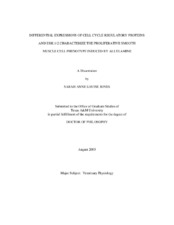| dc.description.abstract | Chronic oxidative injury by allylamine induces proliferative vascular smooth muscle cell (vSMC) phenotypes in the rat aorta similar to those seen in rodent and human atherosclerotic lesions. In this study, we evaluate the potential role of cyclin dependent kinase inhibitors, p21 and p27, and extracellular regulated kinases (ERK1/2) to mediate the proliferative advantage of oxidatively stressed (i.e. allylamine injured) vSMC. Isolated rat aortic SMC from allylamine treated and control rats were cultured on different extracellular matrix (ECM) proteins. Following mitogen restriction, cultures were stimulated with serum with or without inhibitors of NF-kB or MEK. Western blot analysis was performed to identify protein differences between treatment groups. Basal levels of p21 were 1.6 fold higher in randomly cycling allylamine cells than control counterparts seeded on a plastic substrate, a difference lost when cells were seeded on collagen. p27 levels were comparable in both cell types irrespective of substrate. Basal levels of p21 and p27 were 1.4 fold higher in G0 synchronized allylamine cells compared with G0 synchronized control cells seeded on a plastic substrate. Following cell cycle progression, differences in protein levels were not detected. Treatment with 100 nM pyrollidine dithiocarbamate (PDTC) resulted in significant decreases in p21 and p27 in allylamine cells versus control cells following serum stimulation for 9 hours. This decrease was even greater for p21 in allylamine cells when grown on collagen relative to control cells. Alterations in peak and temporal activation of ERK1/2 were observed in allylamine cells seeded on a plastic substrate as compared to control cells, following serum stimulation. Seeding on collagen decreased the enhanced peak phosphorylation of ERK1/2 and increased the sustained activity in allylamine cells compared with control counterparts. Inhibition of ERK1/2 activity resulted in reduced p21 expression in both cells types, but the response was markedly enhanced in allylamine cells, and preferentially observed on a restrictive collagen substrate. We conclude that induction of proliferative (i.e. atherogenic) phenotypes following repeated cycles of oxidative injury involves ERK1/2 activity and modulation of the cyclin dependent kinase inhibitors, p21 and p27, in a matrix-dependent manner. | en |


